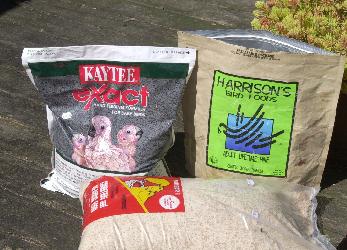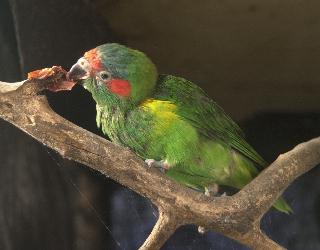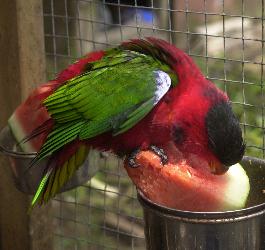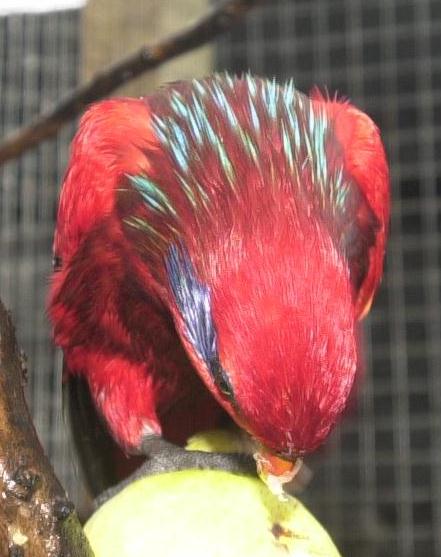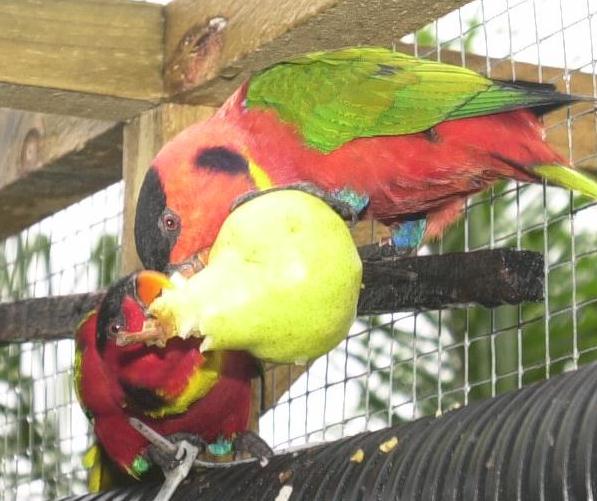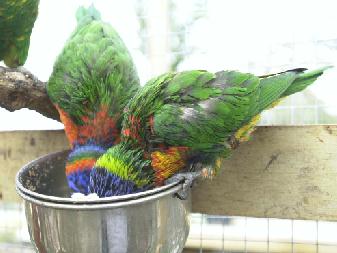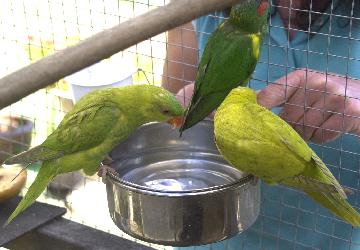Feeding Lories and Lorikeets
Lories and lorikeets, like all animals need food to survive. Unlike many other
birds and especially other parrots, they have a rather specialised diet
consisting mainly of liquid nectar, pollen from flowers and liquid from
fruit and squished things, everything from occasional seeds and greenery to
insects!
When a Lory is kept in captivity it is not too easy to obtain real nectar or
provide a continued diet of flowers so they can extract the pollen. This is
where the substitute nectar comes in and fortunately it is not too difficult
to make a pretty convincing nectar substitite, one that is more than acceptable
to the Lory.
Many Lory owners have their own ideas about making nectars, or wet-mix as it
is often called. Not every bird likes the exact same wet-mix formula and with
some experimenting it does not take too long to find out what favourites an
individual bird has.
But its not just wet-mix that we should feed to lories. They also like a varied diet
with fresh fruit being a special delight, various vegetables and greens should
also be included from time to time.
Dry-mixes are also very popular and along with a suitable water supply can
supply a lot of the lories nutritional requirements.
Lories also like to eat cooked chicken and chop bones, grained breads,
millet sprays, bottle brush flowers, wattle flowers.
It is wise to include a vitamin and mineral supplement in your lorikeets diet. These sorts of supplements are available at most good pet shops. Ornithon is
one of the better known examples.
Lories should be fed at least once a day, preferably several times a day. It
is better to replace small amounts of food several times a day rather than
have a lot go stale after a few hours. Lories, like humans, enjoy fresh
food so if you have the time available then feeding several times a day
is recommended.
Whether inside or outside a container of clean water should be available at
all times, this may need to be changed quite often as lories will often
dunk their food into water and quite quickly it will become very contaminated.
Separate drinking water and bathing water containers are needed.
.
Food to avoid
Below are listed some food items that should be avoided at all costs as
they will often be or are guaranteed to be detrimental to the Lory's well being
and in the worst case could lead to a very ill Lory or even a dead Lory.
- chocolate of all types, normal, dark, milk types,
- tea and coffee, the caffine is definitely not a good idea for lories,
- alcohol will make a Lory dead, they do get exposed to small amounts of alcohol
from fermenting fruit in the wild BUT never give a Lory alcholic beverages
designed for human consumption,
- milk products, flavoured and sweetend milk based beverages, butter and
sweetened yoghurt, ice-cream products,
- potato chips, they are cooked in oil and some lories will pig-out on this high
energy food,
- lollies and sweets for human consumption, they contain too much processed
sugar and if fed to excess could lead to a diabetic bird,
- health supplements designed for human use, these are now very popular and
sold as a health drug often containing all sorts of vitamins, minerals
and extracts from various plants and sometimes fish or animals,
- drugs of any type prescribed for human use, no matter how miserable your
Lory appears NEVER be tempted to feed aspirin or ANY other drug, this means
feeding directly or mixing into other foods, (see your avian vet instead!),
- Avacado is one of the few stone fruits that must not be fed to a Lory.
Commercial wet-mix and dry-mix
There are several commercial dry and wet mixes available for lories and lorikeets. These tend to follow well established and successful formulae and are
packaged in several sizes. Most pet stores will make their own mixes or
purchase them locally and package them in sizes from several hundred grams to
several kilograms. The larger the size then usually the better the value as
packaging costs greatly influence final pricing.
Pictured below are several commercial mixes, at the bottom is a Dutch
formula wet-mix that is very popular (NZ$38 for 5Kg), left is Kay-Tees, a USA manufactured
wet-mix that is excellent for hand raising baby lories (NZ$65 for 2Kg)
and Harrisons Bird
Foods, a pellet based organic food that is advertised as a complete Lory
diet ($114 for 2.5Kg).
Commercial Lory feeds |
Fruits, Vegetables, Greens and other feeding suggestions
Many fruits, vegetables and greens are suitable for lories and lorikeets. You
may need to experiment and offer different items as birds can be quite
different in their food likes and dislikes. Listed below are some of the
foods that have been successfully fed to lories.
- The most popular fruit with lories and lorikeets has to be the apple,
especially the firm crunchy apple containing lots of juice. An apple that
has become mushy and dried up, even slightly, will be ignored by the Lory
after a first testing bite,
- Other similar fruits such as pears and nashi are equally popular, the
firmer and juicier the better,
- Grapes, all varieties, are also a favourite, the lory will also enjoy chewing
and squashing the grape stalks and pips and can often be seen using the mush
created to tuck into plumage,
- Watermelons are a seasonal favourite. The abundance of sweet
liquid is a delight for the lory and the seeds in the watermelon are great fun
with plenty for everyone,
- Cherries, once they are over ripe and bursting with juice.
- Dried fruit is often very acceptable, try sultanas, raisins, dates, figs,
apricots, cranberries, peaches, etc.., these can also be offered to the birds
after soaking in water, honey water or fruit juice to soften them up. Soaked
figs are often relished,
- Suitable vegetables include sweetcorn, steamed carrot, broccoli, beans, peas,
cooked pumpkin, cooked kumera. Many lories like to eat the mixed vegetables and
corn kernels you buy from the super market in the frozen food section. Some
may enjoy raw carrot and other root vegetables,
- Fresh Greens - puha, dandelion leaves and flowers, chick weed, silverbeet (not the stalk if feeding chicks),
- people often ask about lettuce... Lettuce contains water and provides fibre
otherwise it has no nutritional value,
- Lories like tflowers and seeds, grained breads,
millet sprays, bottle brush flowers, wattle flowers. (There is an article on
safe and unsafe flowers to feed your lorikeet in the article section.),
seeds can be soaked or allowed to sprout,
- A vitamin and mineral supplement can be included in the lories diet. These sorts of supplements are available at most good pet shops. Ornithon is
a well proven brand,
- Lories will enjoy the ocassional meat or fish. Cooked chicked necks appear
to a favourite with many lories and cooked or canned fish, such as tuna, can
also be quite popular.
Red-collar with corn-on-the-cob |
Juvenile musk nibbling dried fruit |
Yellow-bib enjoying watermelon |
Bluestreak eating apple |
Yellow-bibs with a pear |
Food/Water containers and hygiene
Many sizes and shapes of food dishes are available for pet parrots. These range
from simple plastic moulded types to better quuality metal types - usually
stainless steel.
The most common and easy to keep clean food containers are the round
stainless steel cups usually mounted in a wire frame that is hooked onto the
wire of an aviary.
They are generally available in several sizes from small enough for a single
bird to quite large sizes suitable as water containers for birds to bathe
in.
These are recommended because they can be soaked and easily
washed then sterilised in an apple cider solution. These cups can also be
washed in a dishwasher where the heat drying will guarantee complete
sterilisation. The only unfortunate aspect of these versatile cups is that
often the supporting wire frame is made from chromed steel and this will
always eventually get covered in rust. This rust will in turn actually start
to rust the stainless steel cup if it remains in contact for very long. The
support wire frame will need to be wire brushed once it becomes rusty as
flakes of chrome will detach and if swallowed by a bird could be fatal.
Plastic cups, the half round type or type with a plastic perching front edge are
also very popular although not so easy to keep clean. They are more easily broken and may not survive the dishwasher.
These tend to be a fraction of the cost of similar sized stainless steel cups
but are generally much more flimsy and may last only a fraction of the life
of the stainless steel cup.`
No matter which type of container is used for food it is of the utmost
importance that the containers are properly cleaned and sterilised on a regular basis. If possible a second set of containers should be available so that a
clean container can be used at least every day or more often if the lories are
fed more than once a day.
Washing is essential to prevent buildup of potentially dangerous bacteria
in stale leftover food. On a hot day food will tend to go off quite quickly
promoting the growth of bacteria.
Feeding from stainless bowl |
Stainless water dish |
Home made wet-mix and dry-mix formulaes
Home made wet and dry mixes have several advantages over purchasing ready made
mixes from a pet food supplier.
First they should be more economical as directly
buying the ingredients will allow you to shop around for the best value brands
and quantities, many of the ingredients are available at bulk food discount
stores (such as BINN-INN and Woolworth's supermarkets in New Zealand).
Second, you know what exactly is going into the mix and you can choose
to use only ingredients you approve of, avoiding preservatives and colouring
agents, free flow agents etc., or use only organic approved ingredients. The
important point is that you have the choice.
Third, you can adjust the actual contents of the mix to suit the availablity
of seasonal items, provide extra conditioning items to improve plumage,
assist with egg development, build up younger birds etc.. and the birds will
find variations in the mixes more interesting.
Examples of wet and dry mixes used by several bird breeders in New Zealand
are detailed below:
1. KELS 3 IN 1 MIX RECIPE:
3 pkt baby farex (super market)
1/4 cup glucose powder
1/4 cup rice flour
1/4 cup arrowroot flour
1/4 cup pea flower
1/4 cup ground corn meal
1/4 tspn spirilina powder
1/4 tspn kelp granules
1/2 pkt crushed malt biscuits (any plain biscuit will be ok here)
4 wet- bix
2 tblspns pollen granules
1/2 tspn ornithon itamin and mineral supplement
1 cup Katie's Exact handrearing food
1 tspn grated cuttlefish
1/4 tspn kelp granules
Blend all together in a food processor so it becomes a fine powder but not
too fine and store in an air tight container. This mix can be offered dry or
to make into a wet mix just add a small amount of honey and warm water to mix
to a runny consistency.
2. Fruit based wet mix
To make 1 litre, enough for about 10 birds.
The quantities can be scaled up or down depending on the number of birds to
feed. This wet mix should be used the same day it is made although it can
refrigerated for two or three days.
One apple, preferable half a green apple and half a red apple
(a pear or peach can be substituted here or mix of these fruits)
several grapes or cherries if available OR several sultanas
1 level tblspn of dark honey
1/2 weetbix biscuit
1 plain biscuit
1/4 tspn yeast extract (inactive)
1/4 tspn kelp granules or for a change 1/4 tspn of spirulina powder
1 tspn of light olive oil or peanut oil
1/2 tspn of pollen granules
250ml of apple juice (or apple/mango juice)
Place all ingredients together in a blender and make up liquid volume to
1 litre with water and blend into an evenly consistent liquid. In cold
weather use warm water (45 to 50 degrees C)
3. Quick and Easy wet mix(1)
1 level tblspn of dark honey
250ml of any fruit juice
half cup of Dutch mix
250ml of warmish water
Mix all together by stirring or shaking in a drinks shaker. Serve immediately
4. Quick and Easy wet mix(2)
1 425g tin of mixed fruit, pears or peaches with juice
half cup of Dutch mix
water to make volume to 500ml, hot or cold depending on weather
Blend together until of even consistency. Serve immediately
Don't blender the impatient bird! |
Assorted lories feeding |
Group feeding on a bowl of cherries |
Contact us
If you would like to contact
The Lory-Link please send email to Kellie Stewart
(arawa.aviaries@xtra.co.nz)
If you are in New Zealand and would like to find out more about meetings and
subscribing to the Lory-Link newsletter then you can phone Kellie on
AUCKLAND (9) 827-3604 or Fax AUCKLAND (9) 358-0059
.

Tile pattern: Yellow-bibbed lory.
Last modified: 13 February 2002.

